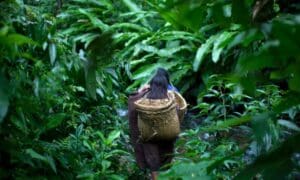
As seen on The Guardian
Peru is home to the second largest block of Amazon rainforest after Brazil and has promising forest protection schemes (including REDD+) in four national parks. But the country has a poor record for fighting deforestation, with rampant illegal mining and logging, slash and burn agriculture and insufficient land titling for indigenous groups.
Tropical rainforests play a crucial role in the health of our planet, especially as carbon sinks. Their importance is highlighted further given the drastic emissions reductions recommended by last month’s report from the Intergovernmental Panel on Climate Change. International donors seem prepared to lay down large sums to protect forests, yet their future still hangs in the balance.
At the UN Climate Change summit in September, Peru signed a $300m (£191m) deal with Norway to reduce net deforestation to zero by 2021, with the aim of cutting greenhouse gas emissions from deforestation and forest degradation. Peru committed to increase by five million hectares the land titled to indigenous peoples and to respect their territorial rights enshrined in the Consultation with Indigenous Peoples Law (guaranteed in the International Labour Organisation’sConvention 169).
The deal was welcomed by Julia Urrunaga, the Environmental Investigation Agency’s director for Peru. However, she pointed out that Peru’s governmentannounced this year it would open up the same amount of land for forest concessions on the back of a new law which seeks to attract investment to the slowing economy.
At the centre of the debate about how to best protect Peru’s 73m hectares of Amazon rainforest are the indigenous people who inhabit it.
The anti-logging campaigner Edwin Chota and three other Ashéninka native leaders were killed in Peru’s Ucayali region in September over land they had spent a decade trying to secure for their community. At least 57 activists have been killed in Peru since 2002, making it the fourth most dangerous country to be an environmental defender.
For Ergilia Rengifo, the widow of Jorge Ríos, one of the leaders, it was clear: “We are the guardians of the forest. Not only for us but also for all. We make sure to keep the water clean, the air clean. Why don’t they value that? Why don’t they give us the title we have been asking for 12 years now?”
But Peru’s President Ollanta Humala doesn’t see it that way: “I don’t agree with labelling them as guardians of the forest; for that the state should hire park guards,” he told the Guardian in a press conference. “I think that’s reducing their importance to simply forest guardians. I believe those communities need development.”
A growing body of evidence links community forest rights with lower carbon dioxide emissions from deforestation and degradation. “More governments and the climate community are recognising the fact that if you want to stop deforestation the most important thing to do is recognise land rights,” said Andy White, coordinator of the Rights and Resources Initiative (RRI).
An RRI-commissioned report conducted in eight tropical forest countries reveals that more than 93% of concessions involve land that is inhabited by indigenous peoples and local communities. The total amount of land handed over by governments to the private sector for mining, logging, oil and gas drilling, and large-scale agriculture includes at least 40% of Peru and 30% of Indonesia.
So what can be done to protect the Amazon, and hand land back to its best guardians? Alberto Pizango, leader of Peru’s largest federation of native communities AIDESEP, believes that Peru’s hosting of the UN Framework Climate Change Conference (COP20) is the last chance to change that paradigm under the umbrella of climate change mitigation. He is asking for 1,070 native Amazon communities to be given pending land titles in an area totaling 20m hectares. A “guarantee”, he said, that there would be “no more deforestation (in Peru) causing global warming”.
Side events at COP20, such as this weekend’s Global Landscape Forum will look at the practical reality of how to use land strategically, factoring in business and community interests. Speakers will include Helen Clark, the former prime minister of New Zealand, and the UN’s third special rapporteur on the Rights of Indigenous Peoples, Victoria Tauli-Corpuz.
The $300 agreement between Norway and Peru should mirror the $150m dealmade between Norway and Liberia to enact a moratorium on new logging contracts and overhaul existing logging concessions that are operating illegally, the EIA said in a statement.
“There is no reason to wait until 2017,” said Urrunaga, referring to the land titling deadline outlined in the statement of intent between the two countries. “Norway should ensure this considerable sum guarantees that communal indigenous land titles start to be granted now and before other land uses are allocated, to avoid further conflict.”
Original article – COP20: Peru must give indigenous people means to combat climate change
